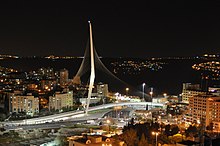Chords Bridge גשר המיתרים | |
|---|---|
 | |
| Coordinates | 31°47′20″N 35°12′00″E / 31.789°N 35.200°E |
| Carries | Jerusalem Light Rail, pedestrians |
| Crosses | Shazar Boulevard |
| Locale | Jerusalem |
| Official name | chords bridge |
| Other name(s) | Bridge of Strings, Jerusalem |
| Characteristics | |
| Design | Side-spar cable-stayed bridge |
| Material | Steel, reinforced concrete |
| Total length | 360 metres (1,180 ft) |
| Width | 14.82 metres (48.6 ft) |
| Height | 118 metres (387 ft) |
| Longest span | 160 metres (520 ft) |
| Clearance below | 3.71 metres (12.2 ft) |
| Rail characteristics | |
| No. of tracks | 2 |
| Track gauge | 1,435 mm (4 ft 8+1⁄2 in) |
| Electrified | Overhead lines |
| History | |
| Architect | Santiago Calatrava |
| Engineering design by | Santiago Calatrava |
| Construction start | 2005 |
| Construction end | 2008 |
| Construction cost | NIS 246 million |
| Inaugurated | June 25, 2008 |
| Location | |
 | |
| References | |
| [1][2] | |

The Chords Bridge (Hebrew: גשר המיתרים, Gesher HaMeitarim), also called the Bridge of Strings or Jerusalem Light Rail Bridge, is a side-spar cable-stayed bridge in Jerusalem. The structure was designed by the Spanish architect and engineer Santiago Calatrava and is used by Jerusalem Light Rail's Red Line, which began service on August 19, 2011. Incorporated in the bridge is a glass-sided pedestrian bridge enabling pedestrians to cross from Kiryat Moshe to the Jerusalem Central Bus Station. The bridge, which cost about $70 million (NIS 246 million), was inaugurated on June 25, 2008.[2]
- ^ "Jerusalem Light Rail Project". Jerusalem Municipality. Retrieved July 29, 2013.
- ^ a b Lefkovits, Etgar (25 June 2008). "Jerusalem landmark inaugurated with gala". The Jerusalem Post.